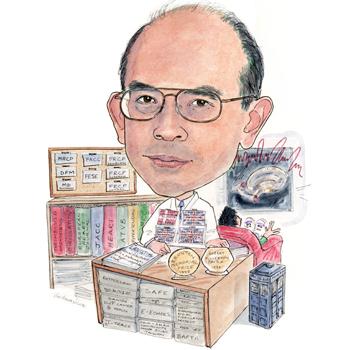
Gregory YH Lip, professor of Cardiovascular Medicine, University of Birmingham Centre for Cardiovascular Sciences, City Hospital, Birmingham, UK, talked to Cardiac Rhythm News about the highlights of his career and the recent update to the European Society of Cardiology (ESC) guidelines for the management of atrial fibrillation.
Why did you choose a career in medicine and, in particular, why did you choose to specialise in cardiovascular medicine?
I come from a family of doctors-my father was in family practice and I have four siblings, who are doctors. Certainly, they were an influence on my choice of career!
I was attracted to cardiovascular medicine as a specialty because of how common cardiovascular disease is.
Furthermore, many of friends and family members had been affected by various cardiovascular conditions. We can do so much more to improve things.
Who has had the biggest influence on your career and why?
My mother-she had atrial fibrillation and succumbed to a stroke. There was less emphasis on the impact of stroke prevention then and there was also little appreciation of the importance to manage the associated risk factors, such as hypertension.
You have a major interest in the research of atrial fibrillation. What, in your view, has been the biggest development in atrial fibrillation?
In my view, the biggest development has been the greater understanding of the pathophysiology of thromboembolism in atrial fibrillation and the availability of the novel oral anticoagulants, which offer greater efficacy, safety and convenience compared with warfarin. Importantly, these drugs provide the opportunity to offer effective stroke prevention to patients with atrial fibrillation with one or more risk factors for stroke.
Of the research you have been involved in, which piece are you most proud of and why?
I would like to hope that I have contributed in a modest way to improving our understanding of the epidemiology of atrial fibrillation, and the associated pathophysiology of stroke and thromboembolism.
This research has led to the development of simple new risk scoring systems, CHA2DS2VASc (congestive heart disease, hypertension, age ≥75 years [doubled], diabetes, stroke [doubled], vascular disease, age ≥65 years, sex category [female]) and HAS-BLED (hypertension, abnormal renal/liver function, stroke, bleeding, labile international normalised ratio, elderly, drug/alcohol intake) that are now used to assess stroke and bleeding risk in atrial fibrillation and both have been incorporated into international guidelines and everyday clinical practice.
What are your current research interests?
I am still very interested in the epidemiology and pathophysiology of thromboembolism in cardiovascular disease, particularly atrial fibrillation, hypertension and heart failure. With various collaborators, I have recently been directing some focus into the global burden of atrial fibrillation, to assess the impact of stroke risk factors in different ethnic groups from different regions of the world. Additionally, patients with atrial fibrillation with chronic renal failure have been a “difficult” group to manage, and we need to understand why these patients are at substantial risk of stroke and bleeding.
Which of your research papers in the last year did you think was the most interesting?
A tough question. Research is a bit like a jigsaw, in which various aspects of one’s research programme complement each other and contribute to the bigger picture.
Many of my papers this year have focussed on various aspects of stroke and bleeding risk in atrial fibrillation, as well as various guidelines and position documents related to atrial fibrillation, thrombosis and bleeding.
What has been your most memorable case and why?
The most memorable case was a 72-year-old woman who developed atrial fibrillation. Her doctor considered her to be at “low risk” of stroke (eg, CHADS2=0) and only treated her with aspirin. She sustained a severe stroke. She was my mother.
In a new update, of which you were a co-author, the ESC now recommends the CHA2DS2VASc rather than the CHADS2 to identify “truly low risk patients”. How many patients identified as low risk with CHADS2 might actually have a higher risk of stroke if CHA2DS2VASc was used instead?
A CHADS2 score of 0 is not “low risk”. If a patient, who was not receiving anticoagulation therapy, with a CHADS2 score of 0 was substratified by the CHA2DS2VASc score, their stroke rate could range between 0.8% per year and 3.2% per year. A CHA2DS2VASc score of 0 is “truly low risk” and has a stroke rate of only 0.8% per year.
In a cohort of 40,000 patients with a CHADS2 score of 0–1, we found that over 60% of them would be classed as having a CHA2DS2VASc score of ≥2 where oral anticoagulation is clearly recommended, and 20% would have a CHA2DS2VASc score of one, where oral anticoagulation “should be considered”. The impact of such a change, at a European level, is great, and our recent analyses would suggest a major impact on stroke reduction that far outweighs serious bleeds, especially if the novel oral anticoagulants are used.
The new guideline also advocates using novel anticoagulants rather than warfarin in patients who require oral anticoagulant. Does this signal the end of warfarin in patients with atrial fibrillation?
The novel anticoagulants offer efficacy, safety and convenience. If used appropriately and correctly, various modelling analyses show that the net clinical benefit is clearly in favour of their use. Very well controlled warfarin (as measured by time in therapeutic range ≥70%) can offer efficacy and safety, and will still be used for certain subgroups of patients with atrial fibrillation, including valvular disease, prosthetic valves, etc. Therefore, this is not really “the end of warfarin”.
The guidelines also advocate using the HAS-BLED score. What are the key benefits of using this score?
The HAS-BLED score should be considered as a calculation to assess bleeding risk, whereby a score ≥3 indicates “high risk” and “caution and regular review” is needed, following the initiation of antithrombotic therapy.
The HAS-BLED score also makes the clinician think about the correctable risk factors for bleeding that should be addressed (eg, uncontrolled blood pressure, labile INRs if the patient was actually on warfarin [otherwise this criterion does not apply], concomitant drugs [aspirin, non-steroidal anti-inflammatory drugs, etc], alcohol excess/abuse etc).
As a new score, its use has been misinterpreted. It is important to note that the use of the HAS-BLED score should be used to “flag up” the patients who may be at risk of bleeding, in an informed way (rather than relying on guesswork), as well as to highlight the modifiable bleeding risks that can be addressed. A high HAS-BLED score per se should not on its own be used to exclude patients from oral anticoagulation therapy, as such patients derive an even greater net clinical benefit from anticoagulation-given that the potential benefit from stroke reduction would outweigh the small increase in serious bleeding risk.
The HAS-BLED score has also been shown to outperform other risk scores, including the older and more complex HEMORR2HAGES score and the less practical ATRIA score. Also, HAS-BLED has a good predictive value for intracranial bleeding, the most severe form of anticoagulation-related bleeding.
How will the new ESC guideline affect the future of stroke prevention in atrial fibrillation patients?
The 2012 focussed update of the ESC guideline recommends a clinical practice shift towards more focus on identification of “truly low-risk” patients with atrial fibrillation, rather than the continued obsession to focus on identifying “high-risk” patients, which was probably relevant when we only had an inconvenient (and potentially dangerous) anticoagulant, warfarin.
Once the “truly low-risk” patients were defined, these patients do not need any antithrombotic therapy. This is hopefully a change in our current thinking, and with this approach to thromboprophylaxis, all other patients with atrial fibrillation (essentially those with ≥1 stroke risk factors) can be offered effective stroke prevention. This approach would help to prevent many fatal and devastating strokes associated with atrial fibrillation.
How do you think the economic crisis will affect healthcare innovation?
Healthcare will always be affected by any economic crisis. New drugs and devices will-unsurprisingly-cost more. However, the available cost-effectiveness studies, including those performed by the UK’s National Institute for Health and Clinical Excellence (NICE), do take a wider view on efficacy, safety and the broader picture of healthcare costs. Thus far, the novel anticoagulations do appear cost-effective-and if you think about it, stroke is a devastating condition providing a major healthcare burden. If we can improve prevention strategies and reduce the healthcare burden, this would be beneficial all round, to patients and the health system.
Outside of medicine, what are your interests and hobbies?
I enjoy travelling with my family-we have had great trips exploring various countries, seeing different sights and trying new cuisines. I enjoy reading, and with my son-we enjoy watching Star Trek and Doctor Who!
Fact File
Current appointments
- Professor of Cardiovascular Medicine, University of Birmingham Centre for Cardiovascular Sciences, City Hospital, Birmingham, UK
- Adjunct professor of Cardiovascular Sciences, Thrombosis Research Unit, Aalborg University, Denmark
- Visiting professor of Haemostasis Thrombosis & Vascular Sciences, Aston University, Birmingham, UK
- Consultant cardiologist, Sandwell and West Birmingham Hospitals NHS Trust, Birmingham, UK
Editorships
- Editor in chief, Thrombosis and Haemostasis
- Guest editor, Circulation
- Associate editor, Europace
Past appointments
1995–1996 Senior registrar in Cardiology, West Midlands Region, Walsgrave Hospital, Coventry (and lecturer in Medicine, University Department of Medicine, City Hospital, Birmingham), UK
1993–1995 Registrar (and honorary postdoctoral research fellow) in Medicine and Cardiology, University Department of Medicine and Department of Cardiology, City Hospital, Birmingham
1991–1993 Clinical research fellow, Department of Cardiology, Stobhill General Hospital, Glasgow, Scotland; and the Haemostasis, Thrombosis and Vascular Medicine Unit, University Department of Medicine, Royal Infirmary, Glasgow
Education
- University of Glasgow, Glasgow , Scotland (MB, ChB. with commendation). Awarded the Brunton Memorial Prize and the Robert Fullerton Prize for most distinguished graduate in medicine and surgery of the year
- Doctor of medicine (1994)
- Diploma of forensic medicine (DFM) with class prize
Societies
- Fellow of Royal College of Physicians, London
- Fellow of Royal College of Physicians and Surgeons of Glasgow
- Fellow of Royal College of Physicians of Edinburgh
- Fellow of the European Society of Cardiology
- Fellow of the American College of Cardiology









